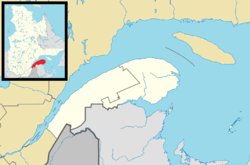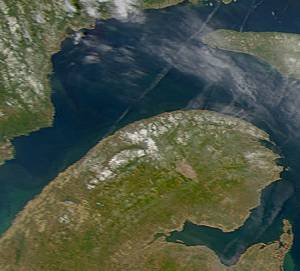
The Gaspé Peninsula, also known as Gaspesia, is a peninsula along the south shore of the St. Lawrence River that extends from the Matapedia Valley in Quebec, Canada, into the Gulf of St. Lawrence. It is separated from New Brunswick on its southern side by Chaleur Bay and the Restigouche River. The name Gaspé comes from the Mi'kmaq word gespe'g, meaning "end", referring to the end of the land.
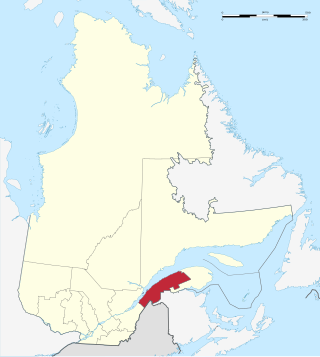
The Bas-Saint-Laurent is an administrative region of Quebec located along the south shore of the lower Saint Lawrence River in Quebec. The river widens at this place, later becoming a bay that discharges into the Atlantic Ocean and is often nicknamed "Bas-du-Fleuve" (Lower-River). The region is formed by eight regional county municipalities and 114 municipalities. In the south, it borders Maine of the United States, and the Canadian New Brunswick and the regions of Chaudière-Appalaches and Gaspésie–Îles-de-la-Madeleine.

Gaspé is a city at the tip of the Gaspé Peninsula in the Gaspésie–Îles-de-la-Madeleine region of eastern Quebec in Canada. Gaspé is about 650 km (400 mi) northeast of Quebec City and 350 km (220 mi) east of Rimouski. Gaspé has a total population of 15,063, as of the 2021 Canadian Census.
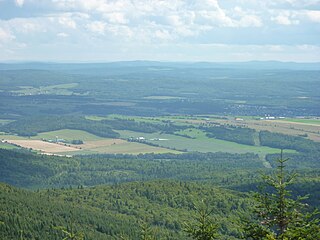
La Matapédia is a regional county municipality (RCM) in eastern Quebec, Canada at the base of the Gaspé peninsula, in the Bas-Saint-Laurent region. Its seat is in Amqui. It is named after the Matapédia River which runs through the western part of the RCM.

Chandler is a town in the Gaspésie–Îles-de-la-Madeleine region of Quebec, Canada. It is the second-most populous town on the Gaspé Peninsula after the Town of Gaspé. It was known as Pabos between June 27, 2001 and May 4, 2002.

The Matapedia River is a river in the Matapedia Valley in the province of Quebec, Canada. It runs on 65 kilometres (40 mi) from Matapedia Lake down to the village of Matapédia where it empties into the left bank of Restigouche River on the provincial border of New Brunswick.
Matane was a federal electoral district in Quebec, Canada, that was represented in the House of Commons of Canada from 1917 to 1935, and from 1968 to 1979.
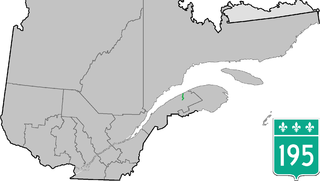
Route 195 is an 87 km two-lane north/south highway in Quebec, Canada, which starts in Matane at the junction of Route 132 and ends in Saint-Zénon-du-Lac-Humqui. The highway acts mainly as a shortcut between Matane and the southern section of Route 132 which leads to the Matapédia River Valley and the southern part of the Gaspé Peninsula.

Matapédia is a municipality at the southern tip of the Gaspé Peninsula, in eastern Quebec, Canada. Matapédia is located along Quebec Route 132 on the border of New Brunswick.

Val-Brillant is a municipality in eastern Quebec, Canada, at the base of the Gaspé peninsula. On the southern shores of the Lake Matapedia, Val-Brillant is part of the Matapédia Valley.

The Matapedia Valley was formed by the Chic-Choc Mountains of eastern Québec. Its name is derived from the river that traverses the valley, as well as the lake that lies in its center. It is situated in the southwest of the Gaspé Peninsula and stretches 375 km (233 mi).
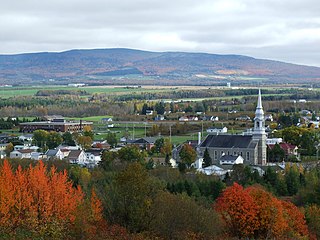
Sayabec is a municipality located in the La Matapédia Regional County Municipality (RCM) in Bas-Saint-Laurent, Quebec, Canada. It is located in the Matapédia Valley between the Chic-Choc Mountains of the Appalachian near Lake Matapédia. The main activities of the village are agriculture and forestry. It has a population of approximately 2,000, the third biggest municipality in its RCM after Amqui and Causapscal. Due to the presence of the chipboards plant called Panval, the biggest industry of the valley, Sayabec is an important regional economic centre.

Amqui station is a Via Rail station in Amqui, Quebec, Canada. Located on Boulevard Saint-Benoît Boulevard Ouest, it is a heated and semi-staffed shelter equipped with washrooms and is wheelchair-accessible. Amqui is served by Via Rail's Ocean; the Montreal – Gaspé train was suspended in 2013. Both trains share the same rail line between Montreal and Matapédia.

Causapscal is a city in the Canadian province of Quebec, located in La Matapédia Regional County Municipality. It is located at the confluence of the Matapédia and Causapscal Rivers, along Quebec Route 132, approximately halfway between Mont-Joli and Campbellton, New Brunswick. It is served by the Causapscal railway station and the Causapscal Airport.

Lac-au-Saumon is a municipality in the Canadian province of Quebec, located in La Matapédia Regional Council Municipality in the Matapédia Valley.

Saint-Léon-le-Grand is a parish municipality in Quebec, Canada.

Matane is a town on the Gaspé Peninsula in Quebec, Canada, on the south shore of the Saint Lawrence River at the mouth of the Matane River. The town is the seat for the La Matanie Regional County Municipality.
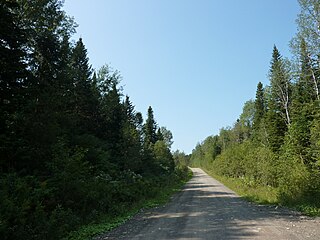
The seignory of Lac-Matapédia is a forest land located on the north shore of Lake Matapédia in the Matapédia Valley in the unorganized territory of Lac-Matapédia, in Amqui, and in Sayabec, in the La Matapédia Regional County Municipality, in administrative region of Bas-Saint-Laurent, Quebec, Canada. The territory is under a "forest supply and management contract" with the Ministry of Natural Resources and Wildlife (Quebec). It is also the regional Park of Lac-Matapédia.
Avignon—La Mitis—Matane—Matapédia is a federal electoral district in Quebec. It encompasses a portion of Quebec previously included in the electoral districts of Gaspésie—Îles-de-la-Madeleine (21%) and Haute-Gaspésie—La Mitis—Matane—Matapédia (79%).

Jules-André Brillant was a French Canadian entrepreneur who was active in the Bas-Saint-Laurent region of Quebec from 1920 to 1962. He founded an electrical power company in 1922, a telephone company in 1927 and a shipping company operating in the Gulf of Saint Lawrence in 1929. He also owned a newspaper, two radio stations and a television broadcaster among other enterprises. He was active in politics, and openly admitted that this was a factor in his business success. After he retired his children took over the business empire, which soon fell apart, with the component companies sold to larger Canadian or American firms.



